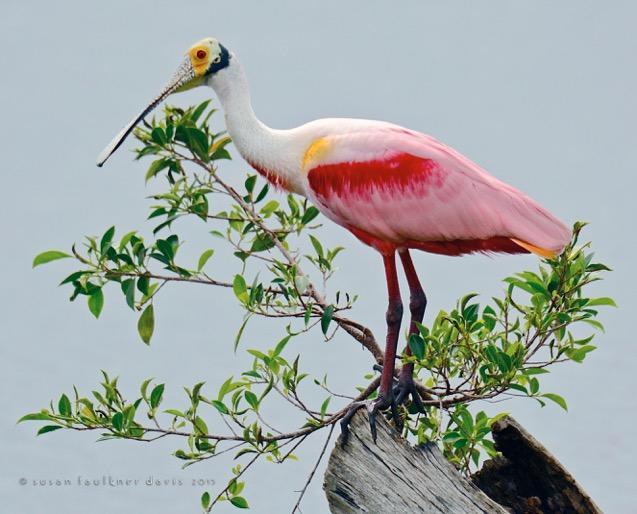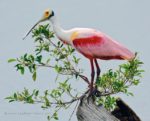
January’s Bird of the Month is the Roseate Spoonbill, and here is the article in the upcoming January 2018 Kite written by Ben Kolstad.
This permanent resident of South Florida’s Everglades ecosystem is the equivalent of a July 4 fireworks display. It consistently garners the most oohs and ahs, and its alliterative taxonomic name, Platalea ajaja, might remind you of that (it used to be the slightly confusingly spelled almost-repeat, Ajaia ajaja). It is also the bird most commonly misidentified by nonbirders, who are more familiar with that other large pink wader in our area, the flamingo. Both birds are large (the flamingo much larger) and pink, it’s true, but that’s about where the resemblance ends.
Where the flamingo’s head is feathered and pink, the spoonbill’s head is bare, like a vulture’s, and has a faint greenish color when seen in good light. The large spatula-shaped bill is instantly recognizable and quite different from the equally specialized feeding apparatus of the flamingo’s muck-strainer. Roseates sweep their bill from side to side and use their bill like tongs to capture prey; flamingos insert their “upside-down” bill into the muck and strain the prey out like a baleen whale, albeit on a slightly smaller scale.
Most “rosies,” as they’re affectionately known, breed on coastal islands, from Tampa Bay on the Gulf to Merritt Island on the Atlantic, although there are some inland breeding colonies as well. It’s designated a species of special concern by the Florida Fish and Wildlife Conservation Commission, which means that its population is considered at risk by at least one of five criteria (rapidly declining population, restricted range/habitat, small population size, risk of extinction greater than 10% in next 100 years, population size fluctuates and/or is fragmented). They meet several of the criteria, since their population size, location, and ability to breed are strongly influenced by water levels for feeding.
Here in Palm Beach County, Roseate Spoonbills are most frequently encountered at the Loxahatchee NWR, Green Cay, the STAs, and the flooded agricultural fields in the EAA (Everglades Agricultural Area).
Photographer’s please note: next month’s BOM is the American Bittern Spoonbill.
Please check out the picture by Susan Faulkner Davis in the January KITE cover and to see the slide show of the entire virtual gallery this month, along with photographer etc — click on BOM SLIDE SHOW below the pictures displayed here:
[flickr_set id=”72157661880218317″]


Comments are closed